
6 minute read
Hyde
from Eastern Living
by Cooke NC
HYDE COUNTY
WHERE WINTER is wild!
Advertisement
Winter has its way of wandering in and suppressing energy with its icy fingers and chilly breaths of wind. While it may cause people to slow down, Winter entertains a variety of activity at the Mattamuskeet National Wildlife Refuge.
The Mattamuskeet National Wildlife Refuge, home to Mattamuskeet Lake - North Carolina’s largest natural freshwater lake - encompasses various habitats within its waters, marshes, wetlands and woodlands.
12
STORY & PHOTOS BY SANDY CARAWAN
While the refuge is situated within 50,180 acres, the shallow lake -18 miles long and five to six miles wide - occupies around 40,000 acres.
Whether a local or an out-of-towner, a bird or wildlife enthusiast, a hiker or a hunter, a photographer or a nature writer, or just someone who wants to escape a city’s chaos, Mattamuskeet National Wildlife Refuge offers some recreational opportunities during the winter season.
In addition to hunting and waterfowling opportunities, there are scattered pull-offs and observation platforms, including the Charles Kuralt Trail, from which to observe wildlife and waterfowl in their natural habitats.
A visit to the Refuge Headquarters Visitors Center, an exceptional facility with helpful literature about the refuge’s offerings throughout all seasons as well as knowledgeable refuge managers and volunteers, is a recommendation.
Additionally, the Visitors Center provides interactive and interpretive exhibits in which
one can learn about the diverse habitats for numerous species such as black bear, deer, bobcat, otter and red wolf, but also waterfowl, wading birds, shorebirds and birds of prey.
One can also learn about the habitats of amphibians including frogs, toads and salamanders as well as reptiles such as yellow-bellied sliders, snapping turtles and various species of snakes. There is also a gift shop.
Visitors don’t have to be bird enthusiasts to enjoy the birds that overwinter at the refuge. But, if one is a birdwatcher, be sure to bring, besides a field guide, binoculars, scopes, DSLR camera and telephoto lens to capture images some may not expect to see: a Pileated Woodpecker perched upon a deadwood tree periodically pecking with its flaming crest vibrating and its echo reverberating throughout the woodland; the Song Sparrows, fluttering in between patches of greenery smothered by winter’s grays and browns, foraging for food among a chorus of other birds’ chirps, chatters and calls. Depending on the season, the refuge hosts over 200 avian species.
Be sure to look down the length of canals for views of wading birds such as the Blue Heron, White Heron or Snowy Egret stalking and striking the mirrorreflections of the water.
Or look upwards where you may see a Northern Harrier, American Kestrel, Osprey or even the majestic Bald Eagle circling and monitoring the marsh below.
A visitor may see a flock of Canada Geese falling out of V-formation as they wing down, punctuating the quietude of the shallow marsh with their shrill falsetto honking of uh-aunk, uh-aunk.
Or they may bear witness to one of the most wondrous sights to behold: infinite skeins of Tundra Swan winging arcs and angles as they fly from and to the lake whether canvassed against a warming cornflower blue morning sky or sunset’s swirling hues of pink, orange and blue.
Equally incredible is the opportunity to observe these elegant and graceful creatures, truly the harbingers of winter at Mattamuskeet Lake, during the daytime. However, the best times of day to observe the Tundra Swan are not only after sunrise followed by a short window of time accompanied by the warming of the sun, but shortly before sunset. Otherwise, they will be occupying impoundments and fields throughout Hyde County.
Of course, one can see dipping and dabbling in the shallow marsh the Mallard, Green-winged Teal,
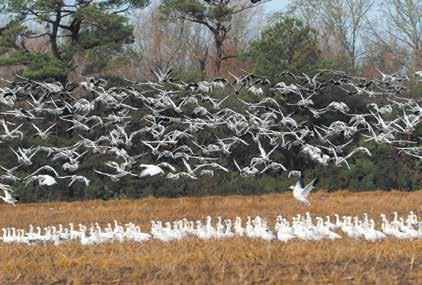
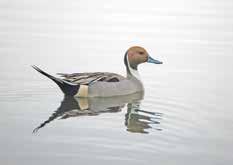
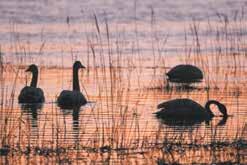
Top: The bald cypress forest and wetland marsh as seen from the New Holland Trail. Second Row Left: Tundra Swans at sunset on Mattamuskeet Lake. Second Row Right: The Northern Pintail duck. Third Row Left: Part of the New Holland Trail coursing through a bald cypress forest. Third Row Right: An interpretive exhibit in the Visitors Office. Bottom: Snow geese fly away from a field. 13

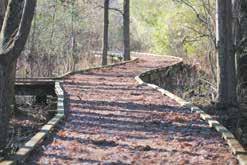
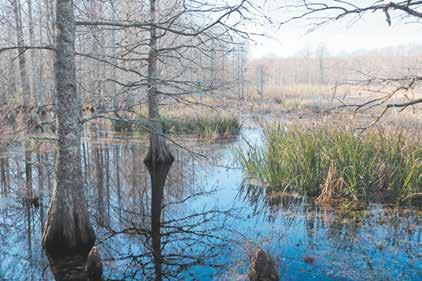
American Coot, Ruddy duck and other duck species.
The refuge is home to numerous species of mammals varying from the black bear, white-tailed deer, red wolf, bobcat, red and gray foxes and nutria, to various species of reptiles such as turtles, lizards, snakes and even alligators. But the latter is something to look forward to seeing during the warmer months of the year.
Hunters are permitted to hunt Tundra Swan, Snow Geese, Canada Geese, ducks, American Coot and whitetailed deer on the refuge, but it is best to check with the Refuge Headquarters or their website regarding each season’s dates.
For the non-hunter, be sure to check access to the refuge as some areas will be closed due to hunting.
There are various walking trails offered to the public. One of the more popular walking trails is the New Holland Trail. The entrance, adjacent to a graveled parking lot, begins at a trailhead kiosk upon entering beneath a canopy of encompassing and entangling thicketed vines. The boardwalk bends and laces through the silence of a bald cypress forest and wetland marsh where your pace may quicken or slow depending on one’s curiosity.
As visitors silently stroll along, senses become heightened by the indistinguishable birds darting and distracting you to follow their seemingly inadvertent path until they camouflage themselves among the thickening branches above cypress knees protruding toward the sky as if a child lying in repose studying the clouds ballooning above the treetops.
Nearby is the famous landmark, the Mattamuskeet Lodge, having formerly been a pumping station used in the early 20th century to drain the lake’s massive acreage to convert it to rich farmlands. During the mid-20th century the building served as a hunting lodge, and years later it hosted various community events before closing.
Perhaps this is the joy of being outside no matter the season — seeing what you don’t expect to see; thinking about what you don’t expect to think about; and leaving feeling refreshed and renewed as you await spring.
The Mattamuskeet National Wildlife Refuge is located nine miles east of Swan Quarter and can be accessed via U.S. 264 or U.S. 94.
For further information, visit the Mattamuskeet National Wildlife Refuge online at www.fws.gov/ mattamuskeet or contact them by telephone at (252) 926-4021.
Sandy Carawan is an English Language Arts teacher at Mattamuskeet Early College High School in Swan Quarter, and is a regular contributor to Eastern Living Magazine.
14

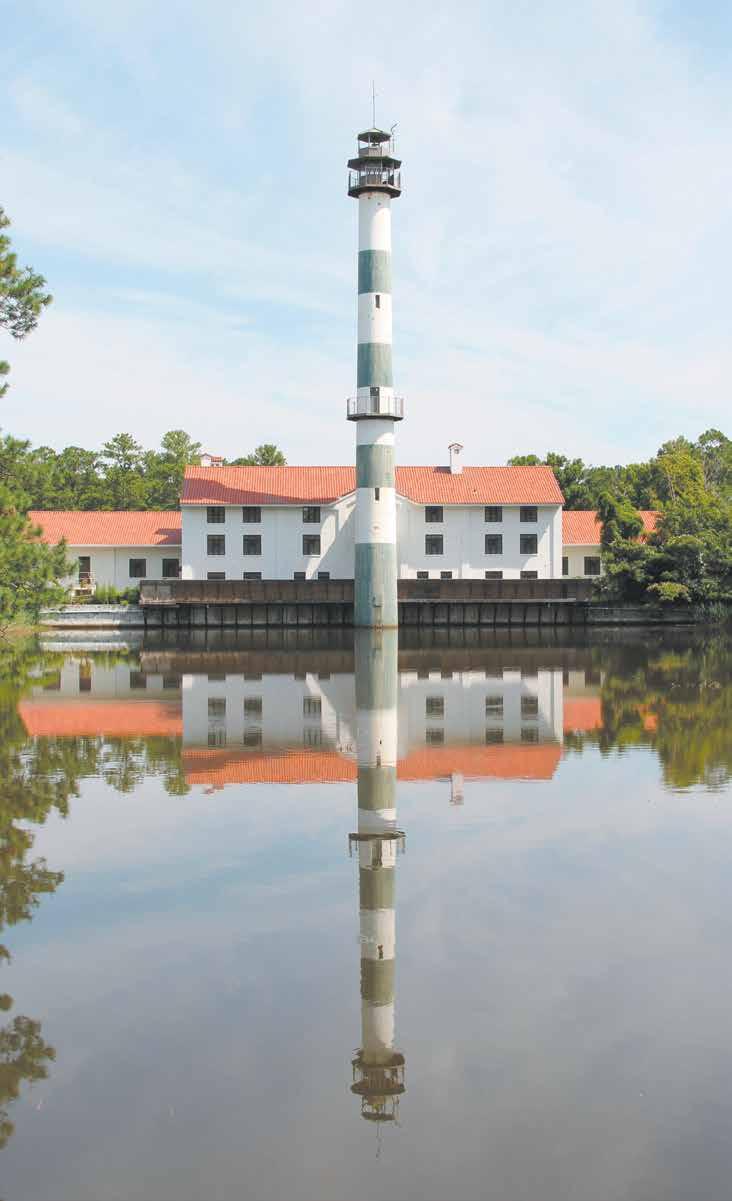



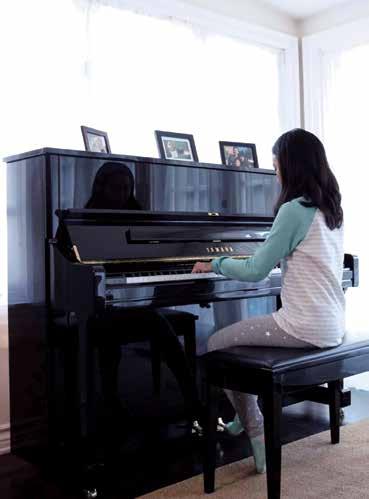
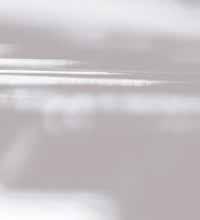
15









